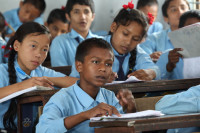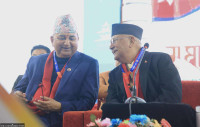Opinion
The Himalayan opportunity
The third Himalayan Consensus Summit brought together 75 speakers from around the world who elaborated on a variety of issues that impact those who live in the Himalayan region and make up one third of humanity.
Sujeev Shakya
The third Himalayan Consensus Summit brought together 75 speakers from around the world who elaborated on a variety of issues that impact those who live in the Himalayan region and make up one third of humanity. The political boundaries across the fragile Himalayas have impacted the lives of many. When birds take flight, they do not see boundaries; neither do the animals that cross over to different regions, nor do the dust pollutants that impact the health of millions. Up till now, countries have been secretive about the data they gather on river flow patterns or the movement of people, but the time has come to open up discussions to share this data so there is more of a regional focus rather than an individual country focus. The International Centre for Integrated Mountain Development (ICIMOD) a multilateral organisation that is headquartered in Kathmandu has now built a repository of knowledge and research. ICIMOD has formed a partnership with the Himalayan Consensus to look into the business aspects of regional partnerships and other organisations can leverage their findings for practical purposes.
Towards Himalayan charter
Former foreign secretary of India and former ambassador to China and US Nirupama Rao proposed that a group of nations in the Himalayan region sign a charter that will delve into areas of mutual cooperation and action. She reflected on the principles of Panchasheel, the five principles that China and India signed off on 60 years ago. Recognition of shared boundaries, shared ecologies, cross border connectivity and sustainable development challenges is important. The fragile Himalayan space needs to be protected, and heritage—both tangible and intangible— needs to be conserved. David Molden, director general of ICIMOD, proposed the formation of a Himalayan Council that would have the task of working on specific issues related to the future of the Himalayas.
What is also required is a platform for track two dialogue as both China and India are trying to work together on economic issues and figure out ways to further strengthen cooperation. The global landscape has changed in the past two years; the US is increasingly preoccupied with domestic issues, Brexit has brought about a new set of discourse, and the free movement of people across geographies is now being questioned.
Contrary to what we read in the media and reports formulated as a result of western perspectives on Asian issues, the China-India relationship has improved significantly. Now, Prime Minister Modi and President Xi Jingping have developed a personal working relationship. More Chinese investments are visible in India, and in China, Indian students rank third in number amongst all foreign students. There has also been more movement of scholars and pracademics between the two countries. At the Himalayan Consensus event in January in New Delhi, it was surprising to see interesting developments in regards to the relationship between the two countries. Though the issues regarding Doklam strained this relationship in the short term, we can expect some historic announcements coming up in May as Prime Minister Modi will visit China for the fourth time in as many years, followed by President Xi Jingping’s visit to India later in the year. Never in recent history have there been so many visits and interactions between the leaders of the two countries. China realises it cannot fully move forward with its Belt and Road Initiative (BRI) without the support of India, and India fully realises that by joining the New Development Bank (BRICS Bank) and Asian Infrastructure Investment Bank (AIIB) it has put its foot in the door and needs to figure out how it can take advantage of the new paradigm instead of trying to oppose it.
As Board Member Professor Mahendra P Lama says, the Himalayan Consensus works as a perfect platform for discussing how to make China’s BRI and India’s ‘Act East’ policy work, and the Himalayas are at the centre of the two initiatives. The Himalayan Consensus is thus now surely recognised as a platform for track two dialogue.
Unleashing growth unleashing connectivity
Humanoid Sophia, who was awarded an honorary citizenship to the imaginary Kingdom of Shambala at the summit, was very clear that the future of the robots would be better if technology driven China and India can work together. These sentiments were prevalent throughout the summit, as everyone is exploring how to take advantage of the opportunities that connectivity presents. In India and China, discourse now focuses on the glorious past of the 12th century, where the two countries were the most prosperous in the world. It is important to consider how similar levels of prosperity can be achieved in the region with better transportation and connectivity.
Economic growth in the Himalayan region is centred around its topography, landscape and abundant natural resources endowed by nature. However, the future of growth is also dependent on our mindfulness of the fragile ecology and environment. There is also a challenge in ensuring that growth does not invite more conflict, and there is a necessity to keep an eye out for any crises that could be induced either by humans or by nature. History tells us that sharp changes in livelihood patterns and economic transformations can bring about challenges of different natures. Under the aegis of the United Nations, multiple layered dialogues will begin as announced at the Summit. The discussions will continue this year across the region, and especially in Beijing and New Delhi.
Nepal is best positioned to be at the centre of regional and global discourse. After the end of the third summit, we feel that by putting together a global event, we can continue with our aspirations to turn Kathmandu Valley into the Brussels, Davos or Geneva of this region. This is perhaps the biggest Himalayan opportunity for Nepal.
www.sujeevshakya.com




 20.12°C Kathmandu
20.12°C Kathmandu










